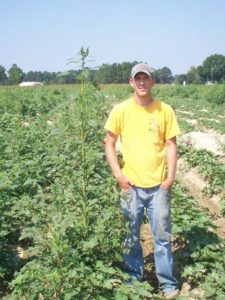As the production season winds down there are two weed-related news items that producers should be aware of:
New Requirements for Users of Paraquat Herbicide. Paraquat dichloride is the active ingredient in products such as Gramoxone, Devour, Cyclone, and Quik-Quat. Earlier this year the Environmental Protection Agency (EPA) announced the following changes to paraquat requirements:
- Additional labeling requirements and the distribution of supplemental warning materials at the point-of-purchase are now required and highlight the toxicity and risks associated with paraquat products.
- Paraquat use is now restricted to certified applicators only. No longer can an uncertified handler use paraquat, even under the direct supervision of a certified applicator.
- Specialized, approved paraquat training is now required for anyone who will mix, load, apply, or handle paraquat.
- New, closed-system packaging will be used to prevent the transfer or removal of paraquat into unapproved containers or equipment.
These changes were sparked by unnecessary deaths of individuals who consumed paraquat which had been illegally poured into drink containers. Three of these deaths were children. Paraquat is highly toxic. Please, make no mistake about it, one sip of concentrated paraquat is nearly always fatal.
Prior to writing this newsletter article, I took the EPA-approved paraquat training. It consists of a 30 minute video followed by a 15 question quiz. The video is well-made, informative, and its content is a good refresher for how to safely handle all pesticides- even though its focus is paraquat. All 15 questions of the quiz must be answered correctly to pass. However, the quiz can be taken as many times as necessary to pass with no required waiting time before reattempting. For more information and a link to the EPA-approved paraquat training, please visit the EPA website here: https://www.epa.gov/pesticide-worker-safety/paraquat-dichloride-training-certified-applicators
Updates to Indiana’s Noxious Weed List. On September 18, 2019 the Office of the Indiana State Chemist received approval to add weedy amaranth species to its list of restricted noxious-weed seeds. This means that weeds such as Palmer amaranth, waterhemp, and other weedy pigweeds will now be subject to restrictions under the state’s seed law. The restriction will not apply to Amaranthus species sold as vegetables, ornamentals, or edible grains for human consumption. According to state seed law, “It is unlawful for any person to distribute agricultural seeds if the seed consists of or contains restricted noxious-weed seeds in excess of 0.25%, or if it contains more than 2.5% of all weed seeds. If less than 0.25% of such weed seeds by weight are present, the number per pound must be declared on the labeling.” Indiana joins Iowa, Minnesota, North Dakota, Tennessee, Washington, and Wisconsin in designating Palmer amaranth as a noxious-weed seed species. Wisconsin also recognizes waterhemp as a noxious-weed seed species. The official update to the Indiana noxious-weed seed list will be October 18, 2019 with enforcement starting January 1, 2020.

The author stands next to a Palmer amaranth plant in sweetpotato research plots in North Carolina, 2007.
By Stephen Meyers, Assistant Professor of Weed Science, Department of Horticulture and Landscape Architecture, Purdue University.